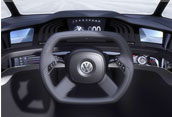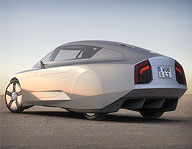 The L1 can seat two occupants in tandem.
They enter through a side-hinging, electrically operated canopy to
maximise the aerodynamic efficiency of the L1 Concept. The result is a
remarkable co-efficient of drag figure of just 0.195.
The L1 can seat two occupants in tandem.
They enter through a side-hinging, electrically operated canopy to
maximise the aerodynamic efficiency of the L1 Concept. The result is a
remarkable co-efficient of drag figure of just 0.195. Not only is the body extremely aerodynamic but it's also very light and strong. The safety cell, constructed from carbon fibre reinforced plastic, weighs just 124 kg. At 3,813 mm in length, the L1 Concept is comparable to the Fox yet at just 1,143 mm in height it's as low as a Lamborghini Murcielago. Its width, at just 1,200 mm, is narrower than any conventional car on sale today.
 The driving environment shares more in common
with an aircraft than a car. The adjustable front seat is thin and
constructed from carbon while the rear passenger sits in a fixed seat
built into the monocoque. The driver has an excellent view of the road
and sits behind an instrument panel set into the body of the car. The
rear view mirror is replaced by an organic light-emitting diode display
while the main controls for the operation of the vehicle are grouped
around the steering wheel.
The driving environment shares more in common
with an aircraft than a car. The adjustable front seat is thin and
constructed from carbon while the rear passenger sits in a fixed seat
built into the monocoque. The driver has an excellent view of the road
and sits behind an instrument panel set into the body of the car. The
rear view mirror is replaced by an organic light-emitting diode display
while the main controls for the operation of the vehicle are grouped
around the steering wheel. Every
element of the L1 Concept is intended to maximise efficiency. At its
heart is a tiny 800 cc two-cylinder common rail, direct injection TDI
engine. In 'ECO' mode the engine develops 27 PS at 4,000 rpm, in
'Sport' mode this rises to 29 PS and 74 lbs ft of torque developed at
1,900 rpm.
Every
element of the L1 Concept is intended to maximise efficiency. At its
heart is a tiny 800 cc two-cylinder common rail, direct injection TDI
engine. In 'ECO' mode the engine develops 27 PS at 4,000 rpm, in
'Sport' mode this rises to 29 PS and 74 lbs ft of torque developed at
1,900 rpm.The modest kerb weight of the L1 Concept linked to efficient aerodynamics mean that it is capable of accelerating to 62 mph from rest in 14.3 seconds before reaching a top speed of 99 mph. Despite having only a 10-litre fuel tank the L1 Concept's incredible efficiency means that it is capable of travelling 416 miles between stops.
The 800 cc engine is derived from the 1.6-litre TDI engine found in the new Golf BlueMotion, also making its debut at the Frankfurt Show. The two have identical cylinder spacing, bore and stroke as well as exhaust gas recirculation and diesel particulate filters to ensure they meet and exceed the Euro-5 emissions regulations. Under normal conditions the 14 PS electric motor is inactive, only engaging when additional acceleration is required, delivering 40 per cent extra torque. In addition, the electric motor can take over from the engine to power the L1 Concept for short distances.







